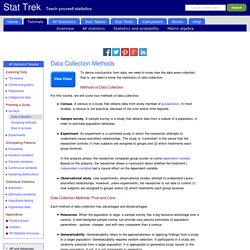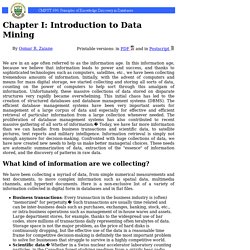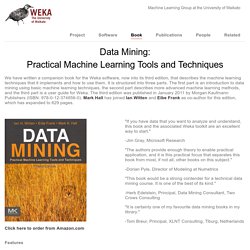

What is Data Mining? Data mining is part of a group of concepts or techniques related to business intelligence, or e-business intelligence.

Data mining involves obtaining information from a variety of sources that is stored in a data warehouse. This information becomes the input for various applications that uncover relationships and trends related to customers and processes. Online analytical processing (OLAP) allows a user to view data from many different angles to uncover correlations and relationships, somewhat like a Rubik's cube (Roberts-Witt, Gold diggers 2001). These results are then used by managers and others to make better decisions. Data Collection Methods. To derive conclusions from data, we need to know how the data were collected; that is, we need to know the method(s) of data collection.

Methods of Data Collection For this tutorial, we will cover four methods of data collection. Chapter 1: Introduction to Data Mining. We are in an age often referred to as the information age.

In this information age, because we believe that information leads to power and success, and thanks to sophisticated technologies such as computers, satellites, etc., we have been collecting tremendous amounts of information. Initially, with the advent of computers and means for mass digital storage, we started collecting and storing all sorts of data, counting on the power of computers to help sort through this amalgam of information.
Unfortunately, these massive collections of data stored on disparate structures very rapidly became overwhelming. What is mobile location analytics (MLA)? - Definition from WhatIs.com. Risk & Fraud. StatSoft - Statistics Textbook. Overview Fraud detection is a topic applicable to many industries including banking and financial sectors, insurance, government agencies and law enforcement, and more.

Fraud attempts have seen a drastic increase in recent years, making fraud detection more important than ever. Despite efforts on the part of the affected institutions, hundreds of millions of dollars are lost to fraud every year. Since relatively few cases show fraud in a large population, finding these can be tricky.
Introduction to Storage. Overview This article provides an extended introduction to Microsoft Azure Storage for developers, IT Pros, and business decision makers.

By reading it, you'll learn about: Database Management - Canary Data Solutions. Getting Started Developing new database systems can be a labour intensive process and requires a strong foundation of database concepts including normalisation, integrity and optimization.

Getting the balance between these factors is essential for minimizing problems, maximizing the value from time invested, and creating maintainable and extendable systems while providing effective and responsive support for application systems. Databases can be developed on top of a number of database management systems to support many varying application frameworks, but all of these use a common theme and Structured Query Language (SQL). Why should you pay attention to your database? Cyber Security services: Safeguarding systems & data.
Data Mining: Practical Machine Learning Tools and Techniques. We have written a companion book for the Weka software, now into its third edition, that describes the machine learning techniques that it implements and how to use them.

It is structured into three parts. The first part is an introduction to data mining using basic machine learning techniques, the second part describes more advanced machine learning methods, and the third part is a user guide for Weka. The third edition was published in January 2011 by Morgan Kaufmann Publishers (ISBN: 978-0-12-374856-0).